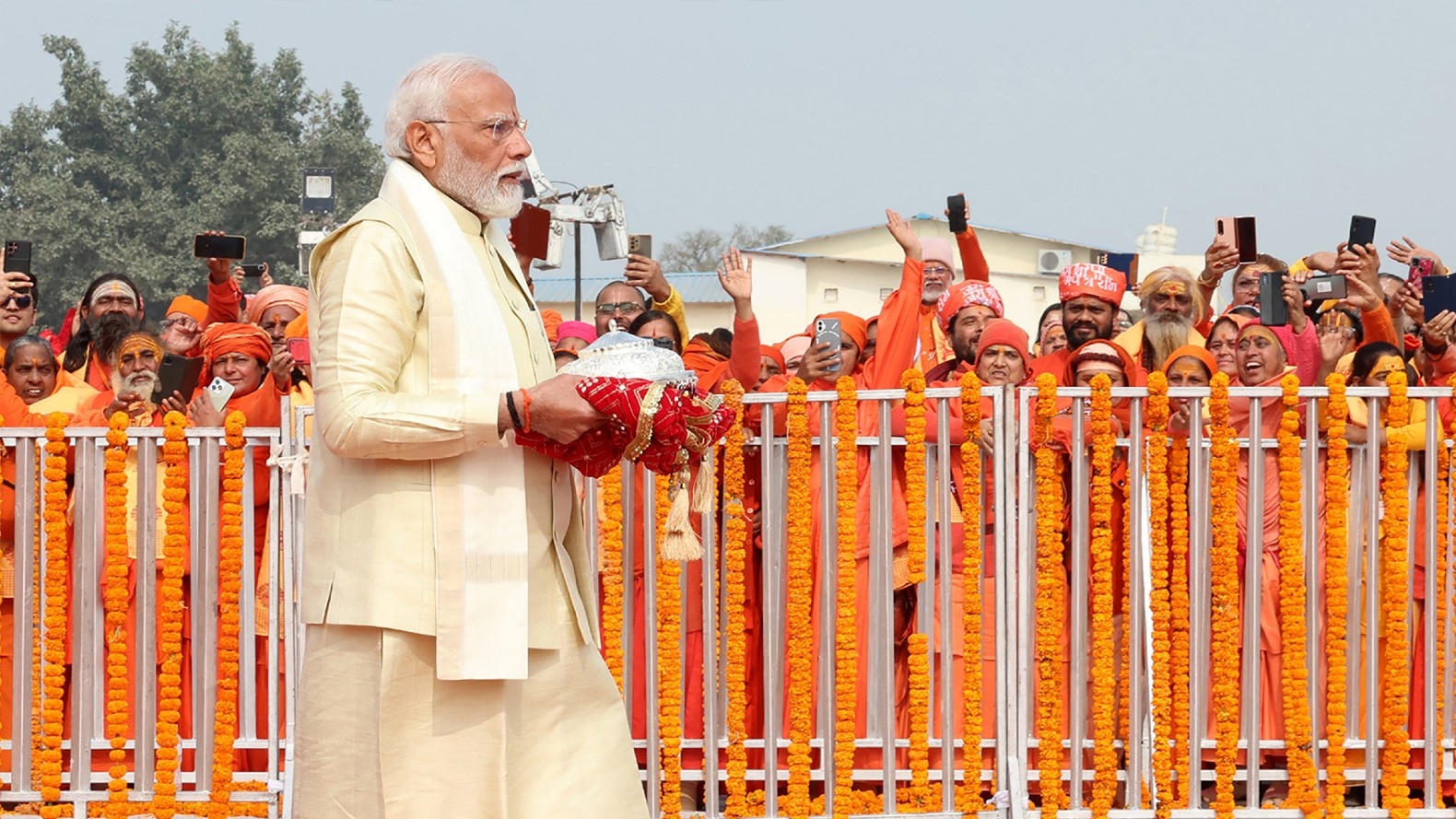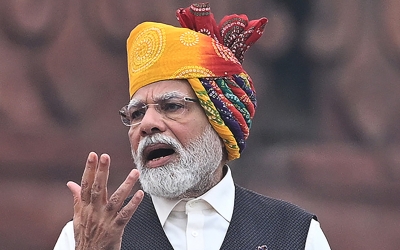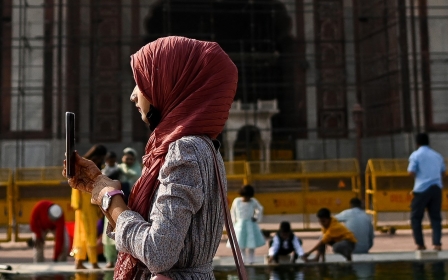India elections: Modi's inauguration of new Ayodhya temple is pure Hindutva populism

Indian Prime Minister Narendra Modi has inaugurated a new Hindu temple at a contentious site where a centuries-old mosque once stood.
In doing so, Modi has sounded the bugle call for India’s high-stakes 2024 national elections, deftly operationalising a communally divisive and emotive issue. This strategy is what originally propelled his Hindu nationalist party to national prominence, and it sets the stage for a polarising election.
As Modi seeks a third term, his ruling Hindu nationalist Bharatiya Janata Party (BJP) has signalled that the crux of its campaign will be anchored in the discourse around Modi’s leadership as a Hindutva icon, and how the party has delivered on its ideological, political and economic commitments.
The epicentre of this political manoeuvring is in Ayodhya, a city in the electorally significant northern state of Uttar Pradesh, and the site of years of bitter strife between Hindus and Muslims. Modi formally inaugurated the Ram temple on Monday, with an idol of Lord Ram, a Hindu deity, placed in the temple’s inner sanctum.
The event was set to attract a formidable crowd, including influential politicians, celebrities and industrialists. Earlier this month, Modi released an audio message noting that he was undertaking a “special 11-day ritual” to prepare himself for the consecration ceremony.
New MEE newsletter: Jerusalem Dispatch
Sign up to get the latest insights and analysis on Israel-Palestine, alongside Turkey Unpacked and other MEE newsletters
Modi had laid the foundation stone for the temple in August 2020, placing a symbolic silver brick in its innermost sanctuary. Afterwards, he said the site had been “liberated”, noting that a “grand house” would be built for Lord Ram, who had been living “in a tent”, referencing a temporary structure housing the idol for decades amid a court battle over the site.
The grandeur of this inauguration serves as a powerful rallying point for Modi and his party ahead of parliamentary polls. The Ayodhya dispute played a key role in the BJP’s ascension to power, establishing Hindutva discourse at the heart of Indian politics. Since the 1980s, the party has pledged to erect a Ram temple on the site.
Through this historic ceremony, Modi fulfils a pivotal campaign promise to his Hindu nationalist support base, and solidifies the party’s connection with its core constituency in northern India’s Hindi heartland. It also sets in motion a campaign aiming to polarise the electorate for political dividends.
Roots of discord
The events leading to the temple’s inauguration have significantly shaped India’s legal, cultural, religious and political history.
The discord surrounding the Ayodhya site traces its roots to the 1500s, when a Muslim Mughal emperor commissioned the construction of a mosque at a site in Ayodhya that Hindus said was the sacred birthplace of Lord Ram. Hindus said the mosque was built upon a pre-existing temple, leading to instances of violence between Hindus and Muslims that have been documented as far back as the 1850s.
For decades, the Ram Janmabhoomi movement has advocated for the repossession of the land and the erection of a temple where the mosque once stood. In the late 1980s, the BJP adopted a resolution demanding the construction of the temple, and in the next election, the party went from having two parliamentary seats to 88.
The issue was further thrust into national prominence during a controversial chariot procession in Uttar Pradesh in 1990 led by veteran BJP leader LK Advani, aiming to galvanise the Hindu vote. The move sparked communal violence in several cities in northern India, with the rally eventually halted in Bihar.
The BJP's electoral strategy has aimed to centre the campaign around Modi as a symbol of Hindutva, development and India's global image
On 6 December 1992, a Hindutva mob demolished the Babri Masjid, with a makeshift shrine swiftly built on the debris of the mosque. The incident triggered countrywide religious riots that killed around 2,000 people, mostly Muslims.
In the ensuing years, Hindu nationalists rallied to build a temple on the land, setting the stage for an emotional and politically charged showdown that lasted nearly three decades.
In 2019, India’s top court, following a lengthy legal battle, granted the disputed land to Hindus and directed the central government to set up a trust to manage and oversee the temple’s construction. Although the court also ruled that the demolition of the Babri mosque was against the rule of law, the decision was seen as a victory for Modi and the BJP.
Leaders of India’s opposition parties have bluntly dismissed the event as a political stunt and election gimmick. The Communist Party of India (Marxist) declined an invitation to the inauguration, and the Congress released a statement categorising it as an event for Hindutva parties. Such criticisms have drawn the ire of the BJP, which in turn has accused its opponents of harbouring “anti-Hindu” sentiments.
'This will be our Vatican'
Adding another layer of dissent, a notable segment of senior Hindu spiritual leaders have opted to stay away, contending that consecrating an unfinished temple runs counter to established scriptural principles, and that the rituals for the inauguration were not being followed as per the Hindu religion.
Through the hasty inauguration ceremony, the BJP seemingly wants to consolidate its pole position by telling the country’s majority Hindu population that the party has delivered on its core ideological commitments.
Indian academic Apoorvanand underlines the reasons for Modi’s rush: “Why is there so much anxiety to install Ram Lalla in an incomplete temple? … Is it because another auspicious time will not come again for the next five years? We all, including those who call themselves true Ram devotees, know that there is only one reason for the rush: the Lok Sabha elections, which are expected to be held after three months.”
The BJP’s electoral strategy has aimed to centre the campaign around Modi as a symbol of Hindutva, development and India’s global image. While this narrative has sought to project the temple as the ultimate symbol of the nation, it has also tried to project Modi as the avatar of an undefeatable leader.
The situation also highlights the Modi government’s agenda of Hindu cultural nationalism, which seeks to woo the country’s Hindi-speaking belt. For Hindutva supporters, the Ram temple transcends the mere symbolism of a Hindu deity, fostering a sense of collective Hindu identity.
“This will be our Vatican City, the holiest site for Hindus across the world,” a spokesperson for the right-wing Vishva Hindu Parishad told the Guardian newspaper.
For Hindu nationalists, the construction of the Ram temple is also a crucial landmark for its singular conception of India as an exclusively Hindu state.
The views expressed in this article belong to the author and do not necessarily reflect the editorial policy of Middle East Eye.
Middle East Eye delivers independent and unrivalled coverage and analysis of the Middle East, North Africa and beyond. To learn more about republishing this content and the associated fees, please fill out this form. More about MEE can be found here.






